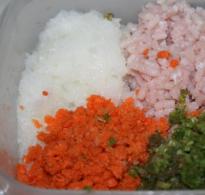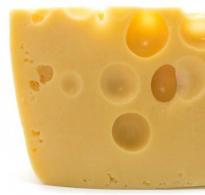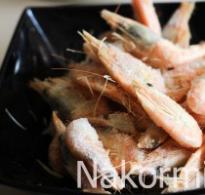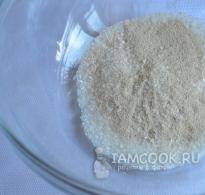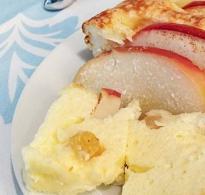White mushroom and its dangerous double. Where is the mushroom, and where is its dangerous double?
Nature played a cruel joke on mushroom pickers this year. The first boletus mushrooms appeared in Belovezhskaya Pushcha in mid-May. It would seem that one can expect a rich harvest. But, alas, the heat made its own adjustments. In this weather, you can only pick mushrooms for soup. And the ban on visiting forests was introduced more than once. So even in the markets the range of nature’s gifts is not impressive, and the price is off the charts. For lovers " quiet hunt“We can only hope for rain. At the same time, now is the best moment to calmly figure out: how not to put toadstool in a basket instead of russula, and what dangerous “doubles” do noble mushrooms have?
Photo by Vitaly Gil
Borovik: not to be confused with satanic
One of the most revered are boletus mushrooms, or porcini mushrooms. They are believed to contain the most complete set of amino acids and improve metabolism. And their extract helps with severe frostbite and angina. Boletus mushrooms are also used in cosmetology: to restore skin structure and improve hair growth. In general, tasty and healthy at the same time. In addition, they are well recognizable, which is important for beginning mushroom pickers.
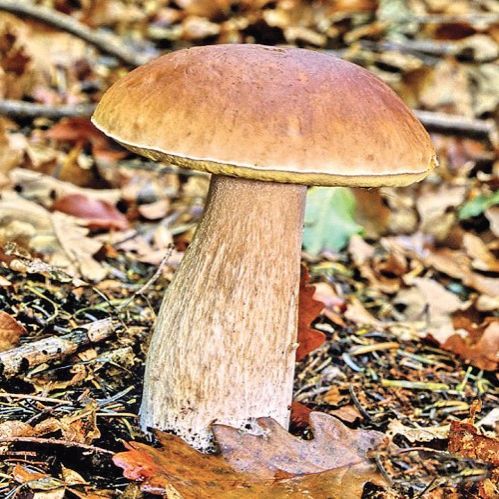
“There are no poisonous boletus, boletus, boletus, or boletus mushrooms,” confirmed Olga Gapienko, head of the mycology laboratory at the Institute of Experimental Botany. V.F. Kuprevich NAS. - Yes, and it’s difficult to confuse them with other mushrooms. Except that gall mushroom, or hare boletus, will come across. Of course, it may spoil your dish, but poisoning will not occur. After all, the bitterness that such a mushroom contains, which only intensifies when cooked, is simply a good choleretic agent. The exception is the satanic mushroom, which is very similar in shape to a boletus mushroom. In its raw form, it is highly poisonous: even 1 gram of pulp can cause severe upset of the digestive system.
How can you tell them apart? Cap color satanic mushroom can be from whitish-gray to lead-gray, yellowish or olive with pink streaks. When cut, the flesh turns a little blue or pink, and in the stem it is reddish. In old mushrooms it has a very bad smell. Fortunately, they are not found in our country...
Breast: not everyone's taste
 The attitude towards milk mushrooms is ambiguous. In some European countries, for example, milk mushrooms are classified as inedible. And all because such a processing method as salting is not used there. In our country, milk mushrooms have long been “collected in carts and salted in barrels.” The main thing is not to forget that mushrooms contain bitter milky juice, so first of all you need to soak them in water (white ones - one day, black ones - maybe two). After this, the water is drained... Milk mushrooms are valued among the people not only for their excellent taste, but also for healing properties. They are believed to help treat tuberculosis. They are also used to prevent the formation of kidney stones.
The attitude towards milk mushrooms is ambiguous. In some European countries, for example, milk mushrooms are classified as inedible. And all because such a processing method as salting is not used there. In our country, milk mushrooms have long been “collected in carts and salted in barrels.” The main thing is not to forget that mushrooms contain bitter milky juice, so first of all you need to soak them in water (white ones - one day, black ones - maybe two). After this, the water is drained... Milk mushrooms are valued among the people not only for their excellent taste, but also for healing properties. They are believed to help treat tuberculosis. They are also used to prevent the formation of kidney stones.
Since there are no poisonous milk mushrooms either, then when correct processing there is no need to look for “false” signs in them. And yet, some types of milk mushrooms are not favored by mushroom pickers. For example, pepper milk, pungent taste which disappears only after prolonged soaking. Some fans, however, dry this mushroom, grind it into powder and then use it as a seasoning instead of pepper. Outwardly, it looks like a dry milk mushroom. Has a funnel-shaped dry cap, creamy white. But unlike its brother, it has a higher stem, and the abundantly secreted milky juice turns bluish or olive-green after drying.
Another representative of the species, which should also be treated with caution, is the camphor milk mushroom (papillary, camphor milkweed). It got its name from its characteristic smell: over time it changes to coconut. This mushroom accumulates a lot of muscarinic substances, which even after processing can persist and cause poisoning. Moreover, it is quite difficult to determine the level of its toxicity at home. You can recognize this mushroom by its brown cap and yellow-cream plates underneath. The shape of the cap is often flat with a depressed center. And as soon as you break it, the flesh immediately darkens. If you press on the cap with your finger, a brown spot with a golden tint usually appears.
Ryzhik: only an amateur would make a mistake
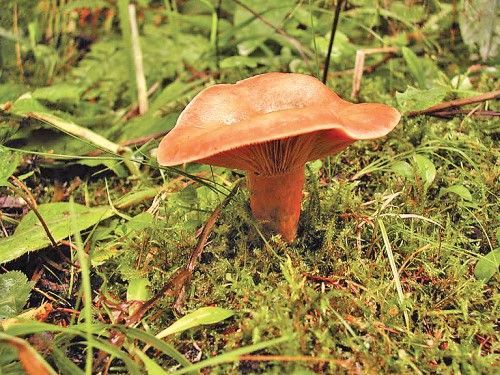 Rizhik is another representative of wild plants, which is revered by connoisseurs almost more than boletus mushrooms. Belongs to the genus Lacticaceae (Russula). It grows mainly on sandy soil in coniferous forests. Distinctive feature- when cut, it secretes an orange milky juice, which changes color when exposed to air. Boiled, fried, salted, pickled - these mushrooms are delicious in any form. Once upon a time in Rus' they were even included in the royal menu. And in Europe they are still considered a delicacy. Of particular value are the so-called bottle saffron milk caps with tiny caps that easily fit into the neck of the bottle. These mushrooms are also very useful. In particular, fungin, contained in saffron milk caps, improves the functioning of the stomach and intestines. And the natural antibiotic lactarioviolin suppresses the development of many bacteria, including the causative agent of tuberculosis. Useful material They are better preserved when salted.
Rizhik is another representative of wild plants, which is revered by connoisseurs almost more than boletus mushrooms. Belongs to the genus Lacticaceae (Russula). It grows mainly on sandy soil in coniferous forests. Distinctive feature- when cut, it secretes an orange milky juice, which changes color when exposed to air. Boiled, fried, salted, pickled - these mushrooms are delicious in any form. Once upon a time in Rus' they were even included in the royal menu. And in Europe they are still considered a delicacy. Of particular value are the so-called bottle saffron milk caps with tiny caps that easily fit into the neck of the bottle. These mushrooms are also very useful. In particular, fungin, contained in saffron milk caps, improves the functioning of the stomach and intestines. And the natural antibiotic lactarioviolin suppresses the development of many bacteria, including the causative agent of tuberculosis. Useful material They are better preserved when salted.
Do saffron milk caps have “doubles”? Some are convinced not. However, inexperienced mushroom pickers may confuse these mushrooms, for example, with the edible, but less valuable pink volyanka, which is also popularly called volyanka, rubella or decoction. They can be distinguished by the color of the plates and juice - in saffron milk caps they are colorless, in saffron milk caps they are orange. Oak milkweed can also be mistaken for a “double”. It grows, however, not in coniferous, but in deciduous forests. The cap is brownish-cream with a dark spot in the center and indistinct circles. The pulp is light cream and exudes a non-bitter whitish milky juice at the break. These mushrooms are not poisonous, but they are not tasty either. So knowledgeable mushroom pickers avoid them.
Attention: Russula!
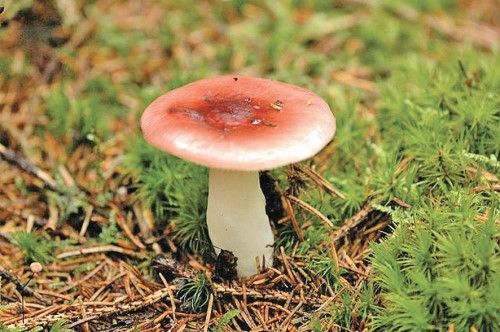 I expected the least trick from her. Even though this is not a first-class mushroom, there is always a place for it in my basket. Perhaps russula got its name because after salting it is very quickly ready for consumption. Of all the variety, those with green caps are considered the most delicious. However, inexperienced mushroom pickers, warns Olga Gapienko, often confuse russula with pale toadstools, which leads to severe poisoning. To avoid mistakes, you need to examine the stem (it is strictly not recommended to buy mushrooms with the stem cut off), by which it is easy to determine whether it is edible or poisonous. By the way, death cap and related species poisonous mushrooms contain extremely toxic compounds: phallotoxins and amanitotoxins. To develop severe intoxication, it is enough to eat at least a small part of the mushroom. The incubation period is from 6 hours to 3 days. At this time, changes in the patient's condition are unpredictable. Gastroenteral disorders develop. The recovery period is from 2 to 5 months. And treatment started late (on the second to fifth day) is often unsuccessful. You also need to be careful with red russula. Among them there are also species that can cause poisoning.
I expected the least trick from her. Even though this is not a first-class mushroom, there is always a place for it in my basket. Perhaps russula got its name because after salting it is very quickly ready for consumption. Of all the variety, those with green caps are considered the most delicious. However, inexperienced mushroom pickers, warns Olga Gapienko, often confuse russula with pale toadstools, which leads to severe poisoning. To avoid mistakes, you need to examine the stem (it is strictly not recommended to buy mushrooms with the stem cut off), by which it is easy to determine whether it is edible or poisonous. By the way, death cap and related species poisonous mushrooms contain extremely toxic compounds: phallotoxins and amanitotoxins. To develop severe intoxication, it is enough to eat at least a small part of the mushroom. The incubation period is from 6 hours to 3 days. At this time, changes in the patient's condition are unpredictable. Gastroenteral disorders develop. The recovery period is from 2 to 5 months. And treatment started late (on the second to fifth day) is often unsuccessful. You also need to be careful with red russula. Among them there are also species that can cause poisoning.
By the way
By taste qualities Edible mushrooms are divided into four categories. The first includes the most valuable: White mushroom, pine and spruce camelina, varieties of milk mushrooms - real, aspen, lilac, yellow. The second included champignons, aspen boletuses, boletus mushrooms, boletus mushrooms, boletus mushrooms, ringed cap, podgruzdki, brilliant greens, green mushrooms and others. Next in the ranking are chanterelles, moss mushrooms, autumn honey mushrooms, valui, cobwebs (there are a lot of inedible ones among this species) and russula. And the list is completed by oyster mushrooms, variegated umbrellas, meadow and summer honey mushrooms, dung beetles, talkers, row mushrooms, tinder fungi, used mainly for pickling. However, this division is arbitrary and largely depends on local traditions. For example, variegated umbrellas and oyster mushrooms, which are not collected in many regions, are revered by residents of other European countries more than boletus mushrooms. And in Finland, some types of hedgehogs, dung beetles, and russula are considered delicacies.
Very often they grow along the side of highways. unusual mushrooms with a large plate-like cap and a thin long stem. Most people think it's white grebe or fly agaric. But in reality, it is an umbrella mushroom, which is an edible and very tasty fruiting body.
The mushroom got its name due to its strong external resemblance to an umbrella. At first, the cap on the stem looks like a closed umbrella or dome, but soon it opens up and becomes a copy of the umbrella. It is important to remember that almost all edible mushrooms have false or poisonous counterparts. Umbrellas are also no exception and have their own inedible “brothers”. Therefore, mushroom pickers need to adhere to certain rules: Do not collect mushrooms that are in doubt.
It is quite possible to distinguish an edible mushroom from a poisonous umbrella. And if, when you come to the forest, you do not know how and where to collect umbrellas, then you do not need to knock them down with your feet, mistaking them for poisonous mushrooms. Perhaps those who come after you will be glad of such a harvest.
We suggest that you familiarize yourself with the description and photo of poisonous umbrella mushrooms. There are 4 types of them in our region: comb umbel, chestnut umbel, brown-red and fleshy red umbel. However, only the first two types are considered the most dangerous.




Poisonous mushroom comb umbrella
Latin name for umbellata comb: Lepiota cristata;
Family: champignon;
Hat: diameter from 2 to 5 cm, similar to a bell in young specimens and prostrate in adult specimens. The color is red-brown, with pointed yellow-orange scales on the surface.
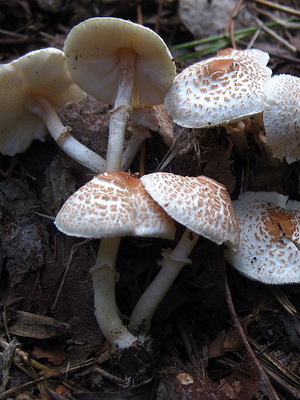

Leg: very thin, empty in the middle, height from 7 to 10 cm, in diameter 0.5 cm in the shape of a cylinder, with a widening base. Color ranges from yellowish to cream, with a white or pink ring. The ring is quite narrow and disappears almost immediately.
Pulp: white flesh with fibrous inclusions, with a sharp unpleasant odor.
Edibility: poisonous, completely unsuitable for food;
Spreading: prefers northern regions countries with temperate climates.
Another poisonous mushroom that looks like an umbrella is the chestnut lepiota.
Latin name: Lepiota castanea;
Family: champignon;
Hat: diameter is from 2 to 4 cm, has a red or brown color. The cap is ovoid only in young mushrooms; in adult specimens it is spread out. Next, the skin on the cap begins to crack into small hard scales of chestnut color. The plates under the cap become yellow over time;
Pulp: has a reddish or brown tint, especially when broken or cut, has an unpleasant odor and is very fragile when touched;
Leg: has a cylindrical shape that expands and descends towards the base. The ring on the leg is white, but quickly disappears with age;
Edibility: the mushroom is very poisonous, and when eaten it is most often fatal;
Spreading: grows in regions with temperate climatic conditions. It can often be found in Eastern and Western Siberia, as well as in European countries.
It is worth saying that the doubles of umbrella mushrooms are poisonous and very dangerous. Therefore, if you do not know exactly what kind of mushroom is in front of you, do not touch it.
How to distinguish the umbrella mushroom from lepiota - a poisonous mushroom? The leg of the poisonous lepiota is up to 12 cm in height, with a thickness of up to 1.2 cm. It is shaped like a cylinder, hollow inside, slightly curved, smooth, white. After the ring on the stem, the color changes and becomes yellowish or brown. If you touch the leg, it turns brown. Look at the photo on how to distinguish the umbrella mushroom from its poisonous counterpart:


How to distinguish an edible umbrella mushroom from a poisonous toadstool and fly agaric (with video)
To know the difference between edible and poisonous umbrella mushrooms, also watch the video. It will help you more accurately identify existing differences.
For example, how to distinguish an umbrella mushroom from? The fly agaric has scales on its cap, but they are rare. Usually the caps of this mushroom are almost smooth, with a small number of white scales. The umbrella is gray or brown with large white or gray scales. The umbrella leg is framed by three layers of white ring that slides down easily.
Many mushroom pickers confuse umbrellas with white toadstools and get poisoned. Therefore, the question arises: how to distinguish an umbrella mushroom from a toadstool?
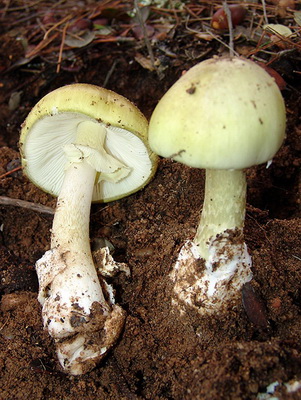

White grebe is a very toxic mushroom, and if accidentally consumed, death occurs in 90% of cases. The entire mushroom has a grayish or off-white tint. Its cap does not have scales, but is covered with flakes. The flesh of the white toadstool has a rather unpleasant chlorine odor. There is no ring on the stem; it disappears very early, leaving fragments of fiber instead.
How to distinguish an edible umbrella from an inedible purple mushroom
There is another false umbrella that can also be confused. How to distinguish edible mushroom an umbrella from the inedible - a purple umbrella? Inedible purple mushroom has the appropriate color, bitter taste and unpleasant odor. Although this fruiting body is not poisonous, it is not recommended to eat it due to its strong bitterness. We invite you to look at a visual photo of the inedible umbrella mushroom:

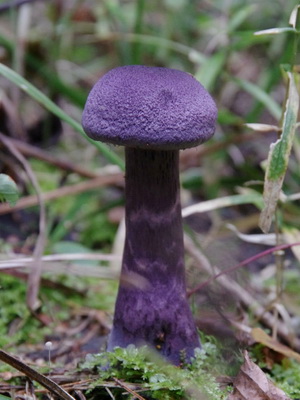
It is worth noting that umbrella mushrooms are very common among representatives of the mushroom kingdom. Since they grow on decaying organic debris, on rotting plants, they are also called saprophytes. Sometimes umbrellas can reach very large sizes, for example, the cap in diameter can be more than 23 cm, and the height of the stem can be up to 30 cm. Umbrella mushrooms grow in circles, forming rings, popularly called “witch circles.” In such circles, umbrellas can grow to several dozen.
Red umbrella mushroom: poisonous or edible?
Some mushroom pickers are sure that the red umbrella mushroom is considered poisonous and therefore do not collect it. We hasten to reassure them, this mushroom is edible and very tasty.

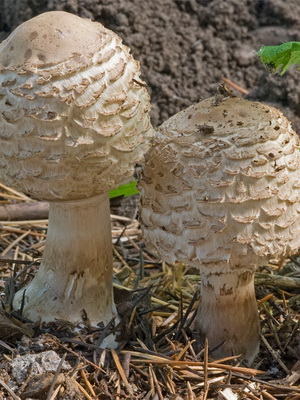
Latin name: Macrolepiota rhacodes;
Family: champignon;
Hat: beige or gray in color with fibrous-looking scales. Young mushrooms resemble a small egg, and then their hat straightens out and resembles a bell. With age, it becomes completely flat with slightly rolled up edges;
Leg: smooth, white or light brown. The shape is cylindrical, tapering at the top and easily separated from the cap;
Records: white or cream color, turns red when pressed;
Pulp: white, very brittle, fibrous. When cut it turns reddish-brown and has a pleasant smell;
Edibility: edible mushroom;
Spreading: deciduous and coniferous forests, acacia thickets. In addition to Russia, it can be found in Europe, Asia, Africa, Australia, and America.
Scientists warn that the red umbrella mushroom, even though it is edible, can cause severe allergic reactions in allergy sufferers.
Inedible white umbrella: what a poisonous mushroom looks like
Another umbrella that mushroom pickers consider inedible is the white umbrella mushroom.

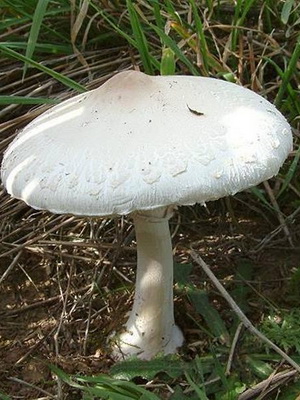
Latin name: Macrolepiota excoriata;
Family: Champignon;
Synonyms: white umbrella, field umbrella, white lepiota;
Hat: gray-white, up to 13 cm in diameter, with scales that easily come off. Young mushrooms look like a chicken egg, then become flat and have a pronounced brown tubercle in the center of the cap. Whitish fibrous compounds are visible along the edges of the cap;
Leg: height can vary from 5 to 14 cm. The inside is almost empty, has a cylindrical shape, and is slightly curved. The leg below the ring is dark in color and turns brown when touched;
Pulp: white, smells pleasant, has a tart taste, does not change when cut;
Records: quite thick, loose, with smooth edges. In young individuals the plates are white, in older individuals they are beige or brown;
Spreading: found throughout Russia, Ukraine, Belarus and many European countries. It grows in steppes, forests, and pastures, especially where there are humus soils.
Now, having read the description of inedible mushrooms, you know what a poisonous umbrella mushroom looks like. Therefore, when going to the forest to pick mushrooms, remember this information and photos of poisonous umbrellas well, so as not to endanger your life.
One more thing important rule for mushroom pickers: Do not collect umbrellas near highways, industrial enterprises and garbage dumps. Even if mushrooms are edible, but grow in such places, they absorb poisons harmful to the human body and can cause poisoning.

